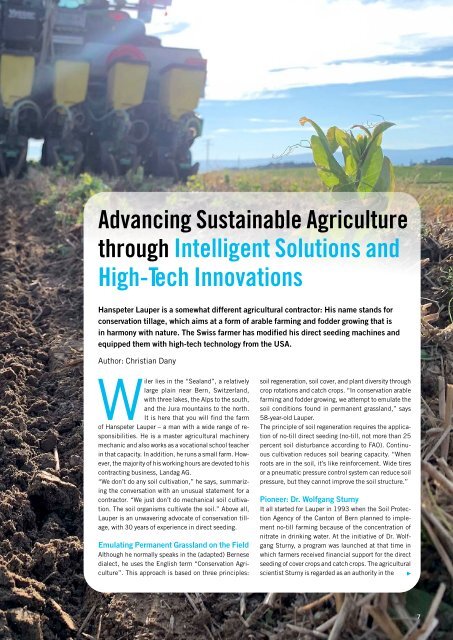Autumn 2023 EN
The German Biogas Association presents its autumn 2023 issue of the English BIOGAS journal.
The German Biogas Association presents its autumn 2023 issue of the English BIOGAS journal.
- No tags were found...
You also want an ePaper? Increase the reach of your titles
YUMPU automatically turns print PDFs into web optimized ePapers that Google loves.
Advancing Sustainable Agriculture<br />
through Intelligent Solutions and<br />
High-Tech Innovations<br />
Hanspeter Lauper is a somewhat different agricultural contractor: His name stands for<br />
conservation tillage, which aims at a form of arable farming and fodder growing that is<br />
in harmony with nature. The Swiss farmer has modified his direct seeding machines and<br />
equipped them with high-tech technology from the USA.<br />
Author: Christian Dany<br />
Wiler lies in the “Sealand”, a relatively<br />
large plain near Bern, Switzerland,<br />
with three lakes, the Alps to the south,<br />
and the Jura mountains to the north.<br />
It is here that you will find the farm<br />
of Hanspeter Lauper – a man with a wide range of responsibilities.<br />
He is a master agricultural machinery<br />
mechanic and also works as a vocational school teacher<br />
in that capacity. In addition, he runs a small farm. However,<br />
the majority of his working hours are devoted to his<br />
contracting business, Landag AG.<br />
“We don’t do any soil cultivation,” he says, summarizing<br />
the conversation with an unusual statement for a<br />
contractor. “We just don’t do mechanical soil cultivation.<br />
The soil organisms cultivate the soil.” Above all,<br />
Lauper is an unwavering advocate of conservation tillage,<br />
with 30 years of experience in direct seeding.<br />
Emulating Permanent Grassland on the Field<br />
Although he normally speaks in the (adapted) Bernese<br />
dialect, he uses the English term “Conservation Agriculture”.<br />
This approach is based on three principles:<br />
soil regeneration, soil cover, and plant diversity through<br />
crop rotations and catch crops. “In conservation arable<br />
farming and fodder growing, we attempt to emulate the<br />
soil conditions found in permanent grassland,” says<br />
58-year-old Lauper.<br />
The principle of soil regeneration requires the application<br />
of no-till direct seeding (no-till, not more than 25<br />
percent soil disturbance according to FAO). Continuous<br />
cultivation reduces soil bearing capacity. “When<br />
roots are in the soil, it’s like reinforcement. Wide tires<br />
or a pneumatic pressure control system can reduce soil<br />
pressure, but they cannot improve the soil structure.”<br />
Pioneer: Dr. Wolfgang Sturny<br />
It all started for Lauper in 1993 when the Soil Protection<br />
Agency of the Canton of Bern planned to implement<br />
no-till farming because of the concentration of<br />
nitrate in drinking water. At the initiative of Dr. Wolfgang<br />
Sturny, a program was launched at that time in<br />
which farmers received financial support for the direct<br />
seeding of cover crops and catch crops. The agricultural<br />
scientist Sturny is regarded as an authority in the<br />
7

















